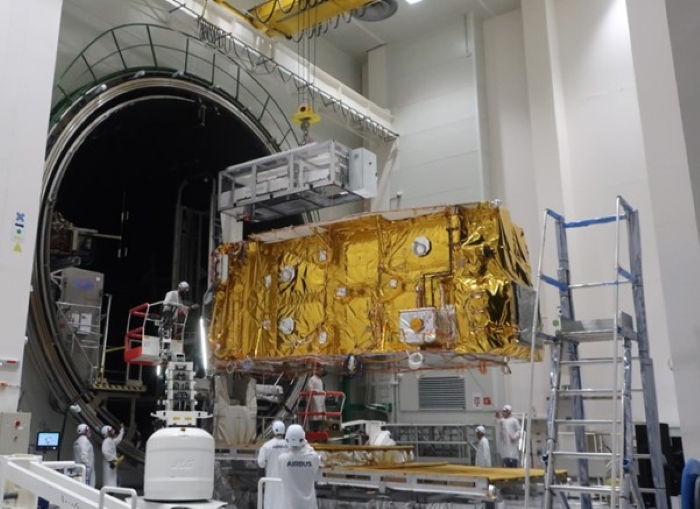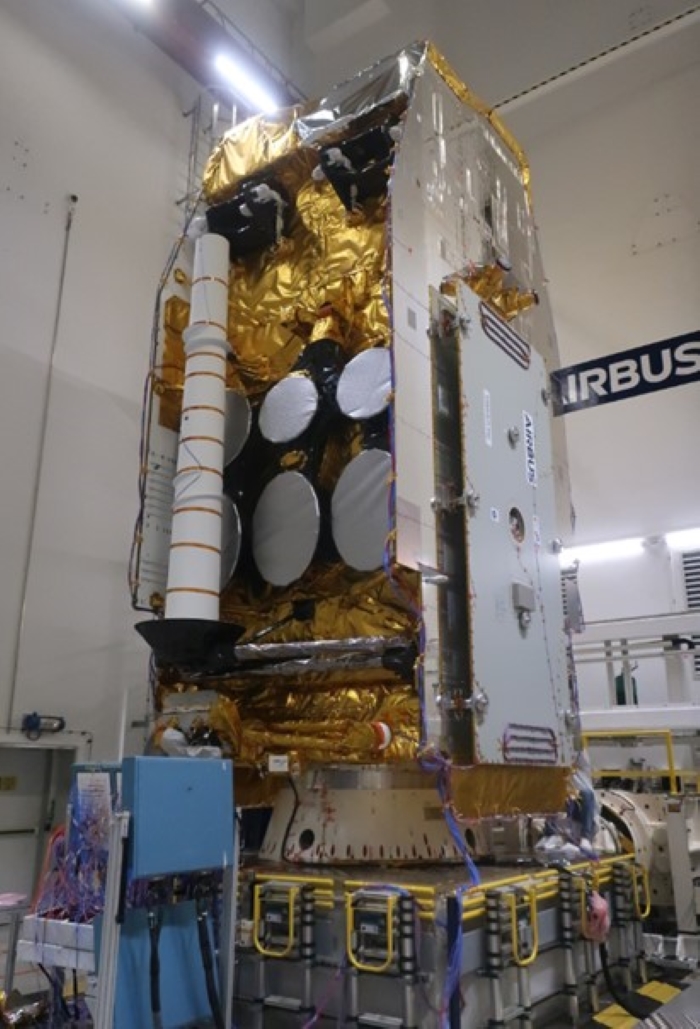Pacis 3 antennas successfully pass environmental testing campaign on board SpainSat NG-1 satellite

The SpainSat NG-1 spacecraft has successfully completed its thermal and mechanical environmental test campaign, marking a crucial milestone for the Pacis 3 project.
Pacis 3 is an ESA Partnership Project between ESA and satellite operator Hisdesat, supported by the Spanish Space Agency. The aim of Pacis 3 is to develop and integrate reconfigurable, active antennas for secure communications at frequencies used by governmental users – representing the most challenging active antenna ever developed in Europe. A pallet of six individually steerable antennas, capable of working at the higher Ka frequency band, are also being developed.
Prior to the spacecraft’s environmental test campaign, the Pacis 3 Transmit (TX) active antenna underwent rigorous testing during its own dedicated campaign, under the responsibility of Airbus Defence and Space, Spain, the industrial prime contractor.
While the Ka-band antenna pallet thermal control is purely by passive means, the Direct Radiating Array (DRA) TX active antenna requires an advanced heat transport system due to its high power density. Designed by Arquimea in Torrejon, Spain, it ensures the antenna remains within its operational temperature limits. The complex and bulky heat transport system was put into place when the Pacis 3 TX active antenna was successfully integrated into the SpainSat NG-1 spacecraft top floor, at the Airbus Defence and Space premises in Toulouse, France.
Following these preparations, the SpainSat NG-1 spacecraft underwent a comprehensive thermal and mechanical environmental test campaign at Airbus Defence and Space in Toulouse. The System level testing was conducted by Airbus Defence and Space Toulouse and in collaboration with Hisdesat, ESA, Airbus Defence and Space Madrid, and Arquimea.
Being part of the Eurostar Neo platform family, SpainSat NG-1 undertook a generic thermal vacuum test sequence. This sequence was amended to incorporate test phases focused on assessing the thermal performance of the Pacis 3 TX active antenna and its advanced heat transport system, with the primary objective of validating the thermal link to the spacecraft radiators.
The tests confirmed breadboard and acceptance levels in heat transport capability and thermal conductance across the entire chain. Additionally, the tests confirmed the thermal gradient management between the Loop Heat Pipes (LHPs) and the Distributed Solid State Power Amplifiers as well as the LHP start-up, parallel operation and shutdown behaviour, and heat sharing capability.
Following the successful thermal vacuum test, SpainSat NG-1 proceeded to mechanical testing. As the satellite, including Pacis 3 elements, is scheduled for launch aboard a SpaceX Falcon 9 rocket, the mechanical tests were adapted to meet the specific requirements of the launcher profile.
The mechanical test campaign included sine vibration testing, acoustic testing, and shock testing for appendage release including the release of the Pacis 3 Ka-band pallet deployment.
Each of these tests was successfully completed, verifying the structural integrity of the spacecraft, the Pacis 3 TX active antenna and the Ka Pallet under the dynamic loads to be seen during launch.

“The successful conclusion of the environmental test campaign is a significant milestone and brings Pacis 3, and the broader SpainSat NG-1 mission, one step closer to launch,” said Oscar Del Rio Herrero, Pacis 3 Project Manager for ESA. “The project and programme represent a strong showcase for the cross collaboration between ESA, its Member States and industry.”
ESA’s Partnership Projects programme, which forms part of ESA’s Connectivity and Secure Communications directorate’s Advanced Research in Telecommunications Systems (ARTES) programme, works to bring its Member States expertise and innovative minds to the global market, developing, de-risking and empowering its industry to build world-leading space solutions.


